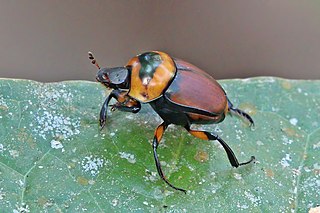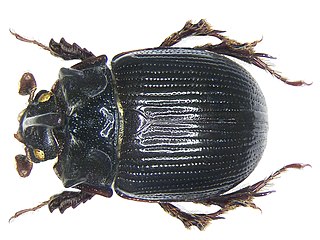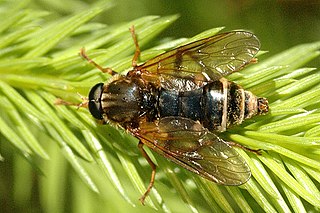
The family Scarabaeidae, as currently defined, consists of over 35,000 species of beetles worldwide; they are often called scarabs or scarab beetles. The classification of this family has undergone significant change in recent years. Several subfamilies have been elevated to family rank, and some reduced to lower ranks. The subfamilies listed in this article are in accordance with those in Catalog of Life (2023).

Giovanni Antonio Scopoli was an Italian physician and naturalist. His biographer Otto Guglia named him the "first anational European" and the "Linnaeus of the Austrian Empire".

Dung beetles are beetles that feed on feces. Some species of dung beetles can bury dung 250 times their own mass in one night.

The rain beetles are a group of beetles whose extant species are found only in the far west of North America. They spend most of their lives underground, emerging in response to rain or snow, thus the common name. Formerly classified in the Scarabaeidae, they are currently assigned to their own family Pleocomidae, considered the sister group to all the remaining families of Scarabaeoidea. The family contains a single extant genus, Pleocoma, and two extinct genera, Cretocoma, described in 2002 from Late Cretaceous deposits in Mongolia, and Proteroscarabeus of Late Cretaceous China.

Trichius fasciatus, the Eurasian bee beetle, is a beetle species belonging to the family Scarabaeidae, subfamily Cetoniinae.

Scarabaeus sacer, common name sacred scarab, is the type species of the genus Scarabaeus and the family Scarabaeidae. This dung beetle is native of southern Europe, northern Africa and western Asia, and it was venerated in ancient Egypt.

Emmelia trabealis, the spotted sulphur, is a moth of the family Noctuidae. The species was first described by Giovanni Antonio Scopoli his 1763 Entomologia Carniolica.

Canthon, the tumblebugs, is a Nearctic-Neotropical genus of Scarabaeidae or scarab beetles in the superfamily Scarabaeoidea.

Heliocopris is a genus of Scarabaeidae or scarab beetles in the superfamily Scarabaeoidea. Forty-seven of the fifty-two known species are found in Africa, but a few are found in southern and southeast Asia.

Megasoma is a genus of rhinoceros beetles. Commonly known as the elephant beetles, Megasoma species are found from the southern half of North America to most of South America.

Oryctes is the most economically important genus of rhinoceros beetles in the subfamily Dynastinae, since it includes a notorious insect pest of palms.

Odonteus is a genus of beetles in the family Bolboceratidae, formerly known by the name Bolboceras. The name Bolboceras was replaced in 1990 when it was discovered that Odonteus had been published one month earlier; this finding was upheld by ICZN Opinion 2138 in 2006, which made the two names synonymous, with Odonteus having priority. Some researchers continue to use the invalid junior name (e.g.).

Bodiloides ictericus is a species of dung beetle in the family Scarabaeidae, found in the Palearctic. It is one of more than 50 species in the genus Bodiloides.

Trichiotinus is a genus of fruit and flower chafers in the family Scarabaeidae. There are about 8 described species in Trichiotinus, all native to the New World.

Melolonthini is a tribe of scarab beetles in the family Scarabaeidae. There are over 250 genera in Melolonthini, occurring worldwide; there are over 300 species in North America alone, and more than 3000 worldwide.

Coenomyia ferruginea is a species of fly in the family Xylophagidae.

Caccobius unicornis, is a species of dung beetle found in many Asian and South East Asian countries such as: India, Sri Lanka, China, Java, Borneo, Taiwan, Korea, Japan, Myanmar, North Vietnam, Philippines, Sumatra, Java, Borneo, Malaysia, Thailand, and Indochina.

Heliocopris bucephalus, commonly known as Elephant dung beetle, is a species of dung beetle found in India, Sri Lanka, Bangladesh, Myanmar, Malay Peninsula, Java, Vietnam, Laos, and Cambodia.

Bodilopsis is a genus of scarab beetles in the family Scarabaeidae. There are at least four described species in Bodilopsis, found in Europe and Asia.



















